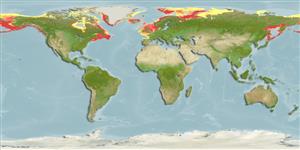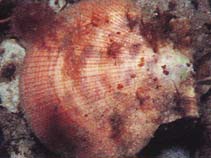Chlamys islandica (Müller, 1776)
Iceland scallop| Native range | All suitable habitat | Point map | Year 2050 |

|
| This map was computer-generated and has not yet been reviewed. |
| Chlamys islandica AquaMaps Data sources: GBIF OBIS |
Classification / Names Populärnamn | synonymer | CoL | ITIS | WoRMS
Bivalvia | Pectinida | Pectinidae
Environment: milieu / climate zone / djupintervall / distribution range Ekologi
; djupintervall 4 - 250 m (Ref. 3710), usually 40 - 100 m (Ref. 106788). Polar; ? - 15°C (Ref. 3706), preferred 10°C (Ref. 107945); 82°N - 32°N, 180°W - 180°E
Distribution Länder | FAO områden | Ekosystem | Förekomster | Utplanteringar
Atlantic Ocean, Pacific and the Arctic: UK and Canadian Arctic Archipelago, Alaska to USA and Japan. Subtropical to polar.
Length at first maturity / Size / Weight / Age
Könsmognad: Lm ? range ? - ? cm Max length : 11.0 cm SHL hane/ej könsbestämd; (Ref. 78075); rapporterad maxålder: 23 år (Ref. 8702)
Life cycle and mating behavior Könsmognad | Reproduktion | Lek | Eggs | Fecundity | Larvae
Main reference
referenser | Koordinator | Medarbetare
Wiborg, K.F. 1963 Some observations on the Iceland scallop Chlamys islandica (Müller) in Norwegian waters. Fiskeridirektoratets Skrifter Serie Havundersogelser 13:38-53. (Ref. 3710)
IUCN Red List Status
(Ref. 130435: Version 2025-1)
CITES status (Ref. 108899)
CMS (Ref. 116361)
Threat to humans
Human uses
Fiskeri: kommersiell
FAO - fiskeri: landings | FishSource | Sea Around Us
Verktyg
Ytterligare information
Max. ages / sizes
Length-weight rel.
Length-length rel.
Length-frequencies
Mass conversion
Abundans
Internet-källor
BHL | BOLD Systems | CISTI | DiscoverLife | FAO(fiskeri: ; publication : search) | Fishipedia | GenBank (genome, nucleotide) | GloBI | Gomexsi | Google Books | Google Scholar | Google | PubMed | Tree of Life | Wikipedia (Go, sök) | Zoological Record



